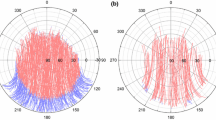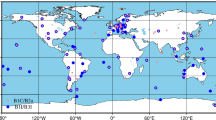Abstract
As the new members of the Chinese Fengyun-3 meteorological satellites series, the Fengyun-3C (FY-3C) and Fengyun-3D (FY-3D) satellites were launched in 2013 and 2017, respectively. For the first time, both FY-3C and FY-3D satellites carry a high-precision BDS and GPS dual-system space-borne receiver to fulfill their stringent requirement of precise orbit determination (POD). The fusion of BDS and GPS onboard observations can significantly improve the spatial geometry, robustness and reliability of low earth orbit (LEO) POD. In order to achieve high-quality orbit recovery from the onboard GNSS observations, the in-flight calibration of phase center variation (PCV) is a prerequisite. In this contribution, we calibrate the BDS PCV for improving the orbit precision of both FY-3C and FY-3D satellites for the first time. The results show that with the GPS PCV corrections, the residuals of GPS carrier phase observations present a reduction of about 17.6% and 21.9% for FY-3C and FY-3D satellites, respectively, and overlap differences of the GPS-only orbit are reduced on average by 3 and 5 mm. After correcting for BDS PCV, the GPS and BDS combined (GC) POD achieves a better orbit precision for both FY-3C and FY-3D satellites. The application of BDS PCV corrections can contribute to a reduction of up to 12% in BDS phase residuals and a decrease of up to 3 mm in orbit overlap differences in 1-dimension. It indicates that the introduction of the BDS PCV model can significantly improve the orbit precision. Similar orbit precision can be achieved when using the GPS PCV model to replace the BDS PCV model in the GC POD. It demonstrates that for onboard receivers, the GPS PCV model can be used to correct PCV errors of BDS signals, which is commonly used in precise point positioning of ground stations when the BDS PCV is not available. Furthermore, we find that it is feasible to generate an integrated PCV model from both onboard BDS and GPS observations. After application of the integrated PCV model, the FY-3C and FY-3D orbits of GC POD present a better precision than the solution using the single-system PCV model and the largest precision improvement of about 1 mm can be recognized in the radial component. With such a high-quality orbit, FY-3C and FY-3D satellites can be expected to make more contributions to meteorological studies and applications.








Similar content being viewed by others
References
Bai W, Sun Y, Du Q, Yang G, Yang Z, Zhang P, Bi Y, Wang X, Cheng C, Han Y (2014) An introduction to the FY3 GNOS instrument and mountain-top tests. Atmos Meas Tech 7(6):1817–1823
Bi Y, Yang Z, Zhang P, Sun Y, Bai W, Du Q, Yang G, Chen J, Liao M (2012) An introduction to China FY3 radio occultation mission and its measurement simulation. Adv Space Res 49(7):1191–1197
Bock H, Jäggi A, Meyer U, Dach R, Beutler G (2011) Impact of GPS antenna phase center variations on precise orbits of the GOCE satellite. Adv Space Res 47(11):1885–1893
Cai Y et al (2017) In-orbit performance of GNOS on-board FY3-C and the enhancements for FY3-D satellite. Adv Space Res 60(12):2812–2821
Görres B, Campbell J, Becker M, Siemes M (2006) Absolute calibration of GPS antennas: laboratory results and comparison with field and robot techniques. GPS Solut 10(2):136–145
Guo F, Li X, Zhang X, Wang J (2016) Assessment of precise orbit and clock products for Galileo, BeiDou, and QZSS from IGS Multi-GNSS Experiment (MGEX). GPS Solut 21(1):279–290
Guo J, Zhao Q, Guo X, Liu X, Liu J, Zhou Q (2015) Quality assessment of onboard GPS receiver and its combination with DORIS and SLR for Haiyang 2A precise orbit determination. Sci China Earth Sci 58(1):138–150
Haines B, Bar-Sever Y, Bertiger W, Desai S, Willis P (2004) One-centimeter orbit determination for Jason-1: new GPS based strategies. Mar Geod 27(1–2):299–318
Haines B, Bar-Sever Y, Bertiger W, Shailen D, Desai S, Harvey N, Sibois A, Weiss J (2015) Realizing a terrestrial reference frame using the global positioning system. J Geophys Res 120(8):5911–5939
Jäggi A, Dach R, Montenbruck O, Hugentobler U, Bock H, Beutler G (2009) Phase center modeling for LEO GPS receiver antennas and its impact on precise orbit determination. J Geod 83:1145. https://doi.org/10.1007/s00190-009-0333-2
Li M, Li W, Shi C, Jiang K, Guo X, Dai X, Meng X, Yang Z, Yang G, Liao M (2017) Precise orbit determination of the Fengyun-3C satellite using onboard GPS and BDS observations. J Geod 91(11):1313–1327
Li X, Li X, Yuan Y, Zhang K, Zhang X, Wickert J (2018a) Multi-GNSS phase delay estimation and PPP ambiguity resolution: GPS, BDS, GLONASS. Galileo. J Geod 92(6):579–608
Li X, Zhang K, Zhang Q, Zhang W, Yuan Y, Li X (2018b) Integrated orbit determination of FY-3C, BDS and GPS satellites. J Geophys Res: Solid Earth 123(9):8143–8160
Luthcke SB, Zelensky NP, Rowlands DD, Lemoine FG, Williams TA (2003) The 1-centimeter orbit: Jason-1 precision orbit determination using GPS, SLR, DORIS, and altimeter data. Mar Geod 26:399–421. https://doi.org/10.1080/714044529
Mao X, Visser PNAM, van den Ijssel J (2017) Impact of GPS antenna phase center and code residual variation maps on orbit and baseline determination of GRACE. Adv Space Res 59(12):2987–3002
Montenbruck O, Garcia-Fernandez M, Yoon Y, Schön S, Jäggi A (2009) Antenna phase center calibration for precise positioning of LEO satellites. GPS Solut 13(1):23–34
Montenbruck O et al (2017) The Multi-GNSS Experiment (MGEX) of the International GNSS Service (IGS)—achievement, prospects and challenges. Adv Space Res 59(7):1671–1697
Schmid R, Steigenberger P, Gendt G, Ge M, Rothacher M (2007) Generation of a consistent absolute phase-center correction model for GPS receiver and satellite antennas. J Geod 81(12):781–798
Wang C, Guo J, Zhao Q, Liu J (2018) Empirically derived model of solar radiation pressure for BeiDou GEO satellites. J Geod. https://doi.org/10.1007/s00190-018-1199-y
Wanninger L, Beer S (2014) BeiDou satellite-induced code pseudorange variations: diagnosis and therapy. GPS Solut 19(4):639–648
Xiong C, Lu C, Zhu J, Ding H (2017) Orbit determination using real tracking data from FY3C-GNOS. Adv Space Res 60(3):543–556
Zhang Q, Guo X, Qu L, Zhao Q (2018a) Precise orbit determination of FY-3C with calibration of orbit biases in BeiDou GEO Satellite. Remote Sens 10(3):382. https://doi.org/10.3390/rs10030382
Zhang K, Zhang Q, Zhang W, Li X, Ma F (2018b) Precise orbit determination for FY-3C satellite using the onboard BDS GPS observations during 2013~2017. Geophysical Research Abstracts, vol 20, sRef-ID: EGU2018-704-1, European Geosciences Union General Assembly
Acknowledgements
We are very grateful to the International GNSS Service (IGS) for providing the precise orbit and clock products of GPS and BDS at the IGS Web site (ftp://cddis.gsfc.nasa.gov). Thanks also go to the EPOS-RT/PANDA software from Deutsches GeoForschungsZentrum (GFZ), Germany. The onboard BDS and GPS tracking data are available from ftp://59.172.178.17. The numerical calculations have been done on the supercomputing system in the Supercomputing Center of Wuhan University.
Author information
Authors and Affiliations
Corresponding author
Additional information
Publisher's Note
Springer Nature remains neutral with regard to jurisdictional claims in published maps and institutional affiliations.
Rights and permissions
About this article
Cite this article
Lu, C., Zhang, Q., Zhang, K. et al. Improving LEO precise orbit determination with BDS PCV calibration. GPS Solut 23, 109 (2019). https://doi.org/10.1007/s10291-019-0899-y
Received:
Accepted:
Published:
DOI: https://doi.org/10.1007/s10291-019-0899-y




